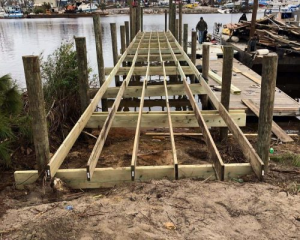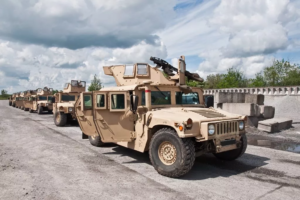Bulkheads are a vital component of waterfront property, and they need to be regularly inspected for signs of damage. Professional bulkhead construction and repair can help prevent erosion and keep your property safe.
Choose a bulkhead builder with years of experience and specialized knowledge. Ask for references and check their reputation. A good builder should provide a detailed proposal and communicate effectively throughout the project. Contact Bulkheads Construction now!

The site preparation phase is the first step in bulkhead construction. It requires careful planning to ensure that all necessary licenses are obtained and that local laws are followed. This includes zoning permissions, environmental permits and building codes. Careful planning can help avoid delays and costly errors that can arise when there is disagreement over regulatory requirements.
Site preparation also involves clearing the construction area, providing access and rough grading. This can be a complex process, depending on the size and location of the project. For example, larger commercial projects typically require more thorough preparation than smaller residential developments.
Next, a foundation is prepared, based on the design and soil conditions. This may include excavation, demolition or installation of water, sewer, gas and underground electrical lines. It is also important to take into account any existing structures that need to be relocated or removed.
Once the foundation is ready, the framework of the bulkhead is constructed. This can be made from a variety of materials, including concrete, steel and wood. In many cases, the foundation will need to be reinforced by additional pilings or piers to prevent damage during construction and operation.
Once the bulkhead is built, it will be inspected and any finishing touches like waterproofing or surface treatments are applied. Regular inspections can help to identify potential problems and make timely repairs.
Foundation Preparation
Bulkheads provide the first line of defense against erosion and flood damage. They stabilize soil, prevent water intrusion, and create usable waterfront space. They also protect buildings and infrastructure from natural elements. Because of these critical roles, bulkheads are built to withstand immense force and pressure. Construction of a bulkhead requires careful planning, design, and execution. This process includes site preparation, excavation and foundation work. The design and material of the bulkhead is determined based on the specific project needs. Depending on the type of bulkhead, the foundation is typically constructed using concrete, steel sheet piling, or wood planks.
The first step in the construction process is to complete a thorough site assessment. This includes analyzing the soil conditions, water depth, and tidal fluctuations. This information is used to ensure that the bulkhead will meet project requirements and comply with local regulations.
Once the site has been surveyed, excavation begins. This is tailored to the specific bulkhead’s design, taking into account unique soil conditions. Care is taken to shape the excavation to facilitate drainage and shape it to minimize potential interference with buried utilities. Precision at this stage is key, as even slight irregularities can impact the structural integrity of the foundation.
Once the excavation is completed, the soil is compacted. This is a critical step in the construction process, as it helps to ensure that the concrete foundation will have sufficient load-bearing capacity. A mechanical plate compactor is used to press soil particles together, increasing density and reducing future settling. The tamping process is repeated several times to achieve uniform compaction. Once the soil has been properly compacted, it is time to prepare the foundation for pouring.
Sheet Piling
Sheet piles are sections of a material with interlocking edges that are driven into the ground to provide support for structures such as retaining walls and excavation supports. They can be made from a variety of materials including steel, timber and concrete. They are available in a range of sizes and shapes and are typically used in conjunction with a bearing system to increase their load-bearing capacity.
During the sheet pile installation phase of bulkheads construction, special care must be taken to ensure that the piles are driven into the soil at the correct depth. A failure to do so can result in a loss of strength and a subsequent collapse of the wall. In addition, if the sheet piles are being used to construct an elevated platform it is important that they be driven into a sufficient depth to provide adequate screening against lateral pressures.
If the soil is rocky or has large boulders, it can be difficult to drive sheet piles into it. In these conditions, it is often more practical to build the bulkhead as a temporary structure and remove it once the work has been completed. Vibratory hammers or impact hammers are typically used to install the piles, but they can cause a lot of vibration and therefore may not be suitable for use in residential areas. Hydraulics can also be used to install the piles if the soil is hard or dense, or if the use of vibrations is prohibited at the site.
Sheet piling is available in a range of shapes and sizes and can be either pre-fabricated or cold-formed on site. The most common type is made from high-strength low-alloy (HSLA) steel. The most commonly-used pile section is the PZ-27, which has a section modulus almost three times greater than that of an arch or flat section with the same weight per square foot of wall. Historically, the selection of the piling section has been based on a number of factors, including the availability of the sections at an economical cost and their ability to meet the design load-bearing requirements.
Installation of Panels or Walls
Bulkheads are constructed to withstand the forces of waves or currents that could otherwise damage buildings, marinas and other waterfront structures. They’re commonly found on residential, commercial and industrial waterfront properties. However, their construction and maintenance can pose real challenges for marine contractors.
When a bulkhead needs repair, prompt action is essential to ensure their integrity and safety. Signs of damage may include deteriorating slab joints, structural instability, or water leakage. When repairs are needed, it’s important to choose a professional bulkhead contractor with experience and a strong reputation.
A bulkhead’s design consists of panels that are repeated along the property’s shoreline, interlocking and connecting with each other via sealed joints. They’re usually made from concrete or another durable material. A berm of soil or riprap supports the toe of the bulkhead at the bottom, and “wales” are spaced out along the water side. These help to distribute the pressure of water and prevent the formation of an uneven force that’s known as hydrostatic pressure.
These walls are then capped with a reinforced concrete “cap.” This helps to anchor the bulkhead panels together and hold unified structural alignment throughout its length. It also helps to prevent debris from washing onto the bulkhead during storms and eroding the protected soils. A French drain is positioned beneath the cap to facilitate drainage and reduce water pressure.
When the time comes to repair a bulkhead, the first step is to address any rusted bolts that may be present. This can often be accomplished by using a wrench and penetrating oil. Once these are taken care of, erosion control mats can be placed to prevent further soil loss and stabilize the area. This can be especially critical if the bulkhead is located in a sensitive environmental area.
Finishing Touches
Bulkheads are exposed to natural elements that can degrade their materials over time. Water, saltwater, sun, and wind can all contribute to this degradation, so it is important to conduct regular inspections of your bulkheads to catch any signs of damage early. When a bulkhead starts to look weathered or worn, it is a sign that it needs professional repair or replacement to ensure it can continue protecting your waterfront property.
In addition to preventing the passage of seawater, bulkheads are also used for fire-resistant purposes. They are insulated with material that prevents heat from spreading to the unexposed side for a certain amount of time after a fire breaks out. They can also be rated to withstand specific levels of pressure.
Whether your home is on the beach or in a waterside community, there are plenty of ways you can make your bulkhead or sea wall more attractive while still ensuring it fulfills its important purpose. For example, you could install removable timber-look wallpaper to give it a rustic charm and provide a stylish aesthetic. You can even hang plate hangers on the bulkhead for a farmhouse feel that will complement any kitchen.
Beacon Marine recently completed a large project to construct a timber and vinyl bulkhead in Chatham, MA. This project involved installing a new bulkhead that tied into an existing stone revetment on one end and a neighboring timber bulkhead on the other. The construction was done without disturbing the existing marina facilities. All of the equipment and materials were transported and staged on barges and work skiffs in order to mobilize and complete the project with minimal impact to the surrounding shoreline.


